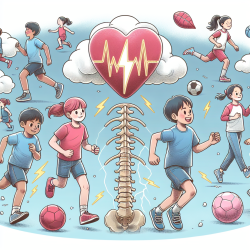Understanding the Complex Relationship Between Cardiovascular Risks and Spinal Pain in Children
As a practitioner working with children, understanding the multifaceted relationships between cardiovascular risk factors and spinal pain can significantly enhance your ability to provide effective care. Recent findings from the CHAMPS Study-DK shed light on these complex interactions, highlighting the moderating roles of sex and physical activity. This blog explores these findings and suggests ways practitioners can leverage this knowledge to improve their practice.
Key Findings from the CHAMPS Study-DK
The study investigated the associations between cardiovascular disease risk factors and non-traumatic spinal pain in children, focusing on the potential moderating effects of sex and health-related physical activity. Here are some key takeaways:
- Girls with low insulin resistance and boys with low clustered cardiovascular risk scores who engaged in high levels of moderate-to-vigorous physical activity reported more weeks of spinal pain.
- Boys with higher cardiovascular risk scores and lower physical activity levels also reported increased spinal pain.
- The relationship between cardiovascular risk factors and spinal pain is influenced by sex and physical activity levels, suggesting a complex interplay.
Implications for Practitioners
These findings have several implications for practitioners working with children:
- Personalized Interventions: Consider tailoring interventions based on a child's cardiovascular risk profile, sex, and activity levels. This personalized approach can help mitigate the risk of spinal pain.
- Promote Balanced Activity: Encourage children to engage in balanced physical activities. While physical activity is beneficial, excessive or insufficient activity, especially in children with certain cardiovascular profiles, may increase spinal pain risk.
- Monitor and Educate: Regularly monitor cardiovascular risk factors in children and educate parents about the potential implications for spinal health. Awareness can lead to early interventions and better health outcomes.
Encouraging Further Research
While the CHAMPS Study-DK provides valuable insights, further research is needed to explore the causal relationships and underlying mechanisms. Practitioners are encouraged to engage in or support research efforts to deepen our understanding of these complex interactions.
Conclusion
The CHAMPS Study-DK highlights the intricate relationship between cardiovascular risk factors, spinal pain, sex, and physical activity in children. By understanding and applying these findings, practitioners can enhance their care strategies, ultimately improving the health and well-being of the children they serve.
To read the original research paper, please follow this link: Associations between cardiovascular disease risk factors and spinal pain may be moderated by sex and health-related physical activity (CHAMPS Study-DK).










